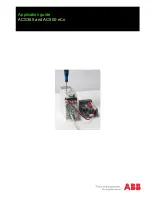
Herz Armaturen
2 / 2
22.04.2013
Enrollment of thermostats (window
sensors)
For each channel of the transceiver, the thermostats can be
enrolled in the following way ( maximum no. of devices is 48):
Repeatedly press button
<
or
>
(left, right arrow) to select the
desired channel (the current channel will be indicated by its LED
flashing).
Insert batteries into the thermostat. When powered up, the
thermostat generates an enrollment signal and its code is stored
in the selected transceiver channel’s memory.
Digital bus thermostats can be enrolled by pressing and holding
their button for 5 seconds.
Enrollment of a thermostat is confirmed by the constant lighting
of the green LED.
Notes:
Enrollment codes are stored in non-volatile memory, so power
disconnection will not erase them.
A thermostat should be enrolled to the first position in the
channel.
A thermostat can be enrolled to multiple channels (or other
transceivers). It allows the control of several channels by one
thermostat.
Channels can be connected via a thermostat on the first position
in each channel only.
The connected channels work like one channel.
The thermostat enrolled to the connected channel can not be
enrolled to other channels.
It is possible to enroll sensors of opened windows (JA-151M) to
channels. Signals from an opened window block a channel, but
will respond to freezing alert signals demanding heating.
Deleting a channel/thermostat
To delete an existing channel/thermostat:
Using buttons < and > select the desired channel (the current
channel will be indicated by its LED flashing)
Press the RES button, the corresponding LED will turn off and all
devices in this channel (or connected channels) will be deleted.
Indicators 1
–16
Indicators on the front housing of the transceiver indicate the status
of the output channels.
LEDs 1 to 16
Meaning
Off
Channel is not used (no thermostat is enrolled)
Steady Green
Channel has a thermostat enrolled, relay is off
Steady Red
Relay is on (activated by the enrolled thermostat)
Flashing Green Communication with the enrolled thermostat is down
(low battery in thermostat, radio interference etc.)
Flashing Red
Enrollment mode (to enroll a thermostat)
Steady red
+flashing green
Channel is blocked by a magnet
Flashing Red
(rapidly)
Output is overloaded or short-circuited.
Using the “ON indicator” channel /
SUMMER input
The transceiver has a special „ON indicator” channel (2) to which a
JA-1xx control panel (PgX output) or RC-1xx remote controls can be
enrolled as well as detectors of type JA-151M.
Repeatedly press button < or > (left, right arrow) to select the „ON
indicator” channel. The current channel will be indicated by its LED
flashing, in thi
s case aim for the „ON indicator” and transmit the
enrollment signal. Enrollment of the transmitter is confirmed by the
constant lighting of the green LED.
If no transmitter is enrolled to the „ON indicator” channel, then
outputs 1-16 react in a standard way to signals from their
corresponding thermostats.
If a control panel is enrolled and the PgX output is activated („ON
indicator” lit red) outputs 1–16 respond to the Stand-by temperature
demanding heating.
If the PgX output is deactivated („ON indicator” lit green), then
outputs 1
–16 are activated in normal operation mode..
LED „ON indicator”
Off
The unit is not powered
Flashing
Green
slowly
The unit is powered
Steady Green
Enrolled component
Steady Red
Standby mode activated
Flashing red
Enrollment mode
Flashing Green
Missing device
Use and maintenance
All enrolled transmitters (thermostats and detectors) transmit
regular check signals. If the transceiver does not receive the signal of
an enrolled transmitter for a certain period, it will indicate that
communication with this device is down (flashing green LED). If all
devices in the channel are lost, then the corresponding output will
turn the heating ON for 15 minutes every single hour. It works this
way independently on „ON indicator”/SUMMER settings
One reason for the lost connection can be low batteries in the
transmitter. The average lifetime of a thermostat’s batteries is about
1 year. Each transmitter checks its battery conditions and signals in
advance if the batteries are reaching a critically low state (see the
transmitter manual for details).
Another reason for possible connection failure can be radio signal
interference in the operational band of the transceiver. In such a case
the transceiver will usually indicate loss of communication with a
multiple number of transmitters. In this situation, check if there is any
non-approved or faulty radio-communicating device within the range
of the transceiver.
If outputs 1
–16 have not been activated for 7 days they will switch
on for 10 minutes to protect connected devices. It works this way
independently on „ON indicator”/SUMMER settings.
Warning: the manufacturer is not responsible for any damage
caused by improper installation or any non-suitable use of this
product.
Specifications
Power supply:
230 V AC, 50Hz
Consumption:
0.02 A stand-by; 0.2 A max.
Max. power supply load
1.8A
Internal load-protection
safety fuse F 3.15 A
Max. relay output load:
10 A / 230V
Voltage of outputs 1
–16:
24V DC
Max. load of outputs 1
–16:
max. 0.4 A per single output
and 1.8A total for all outputs
Radio frequency:
868.1 MHz
Max.number of radio devices
48
Communication range
100 m (open area)
Dimensions:
400 x 100 x 60 mm
Mechanical resistance:
ongoing
Radio characteristics:
ongoing
EMC:
ongoing
Safety:
ongoing
Enclosure:
ongoing
Operational temperature:
-10 to +40 oC
Can be operated according to
ERC REC 70-03
Herz Armaturen
A-1230 Wien, Richard-Strauss-Straße 22
Telefon: + 43/(0)1/616 26 31 -0
Fax: + 43/(0)1/616 26 31 -27
e-mail:
www.herz.eu
Note: Although this product does not contain any harmful
materials we suggest you return the product to the dealer or
directly to the manufacturer after use.




















